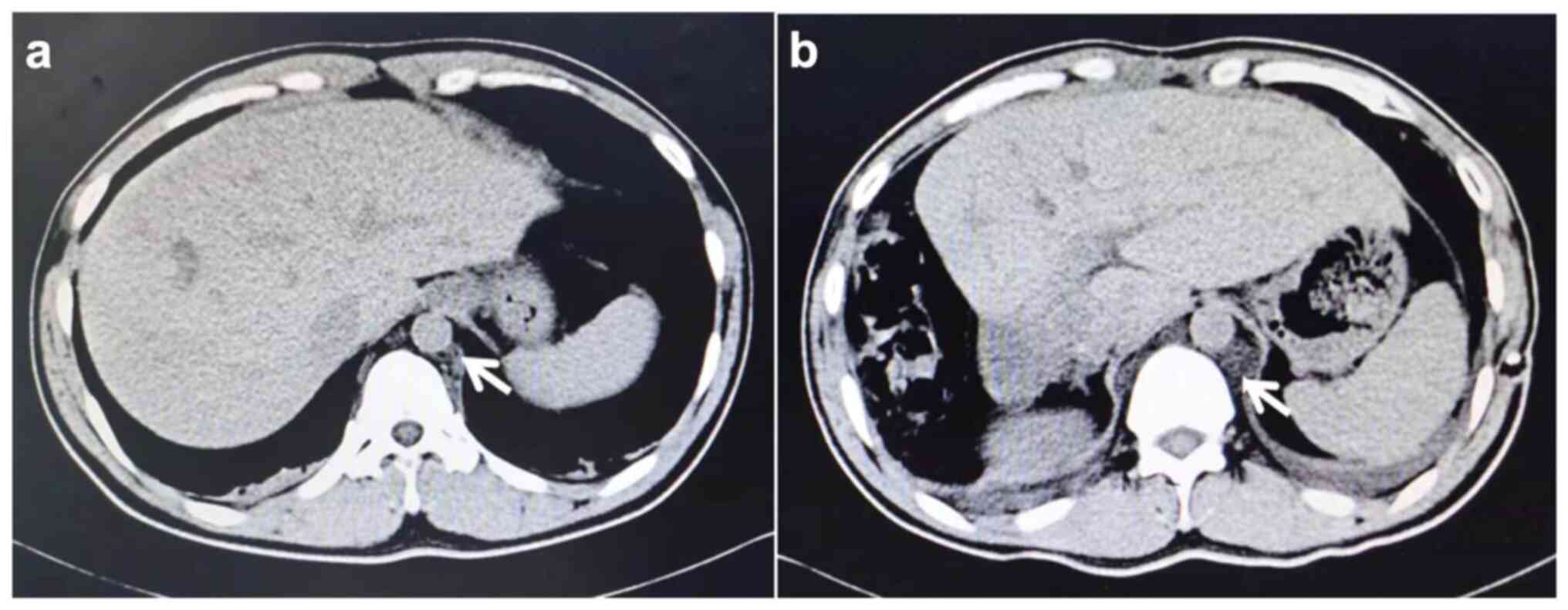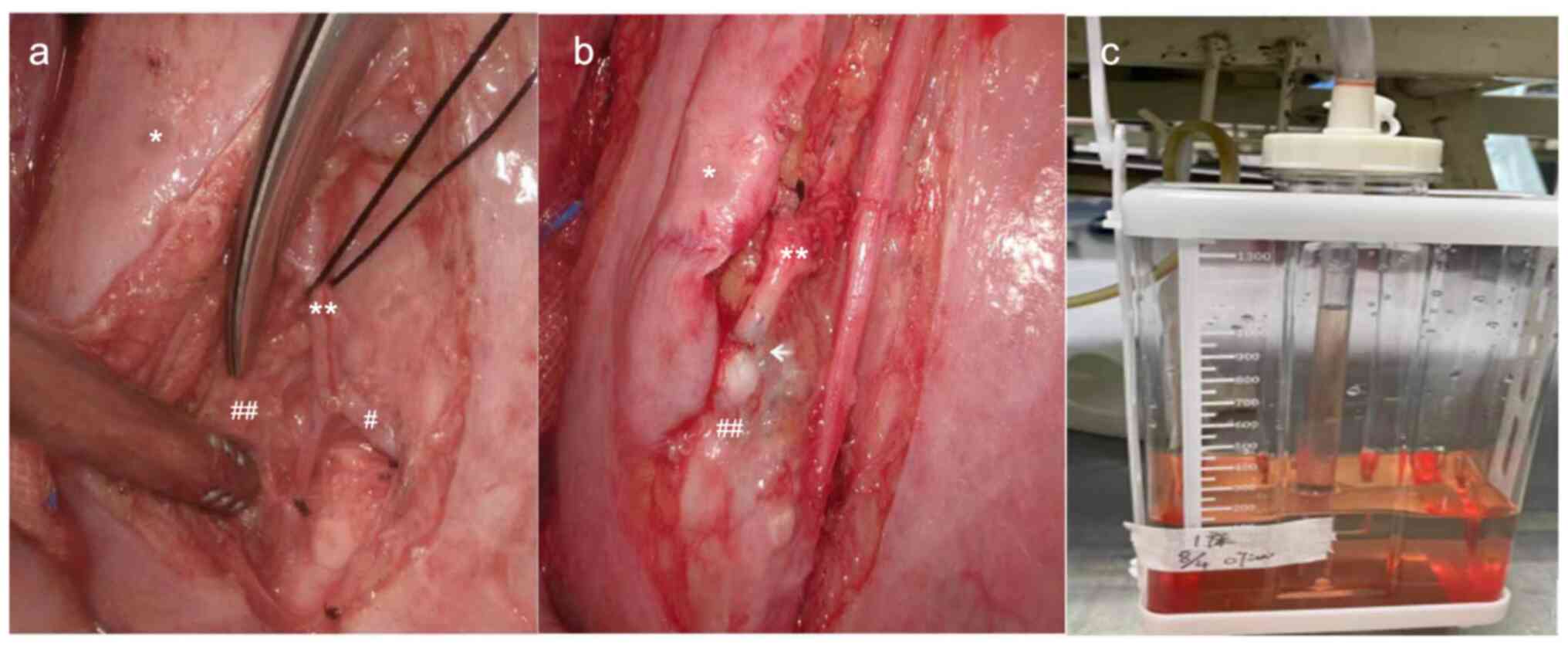Endothoracic lymphatic plexus‑hemiazygos vein anastomosis for chylothorax complicated with hepatocellular carcinoma: A case report
- Authors:
- Published online on: March 19, 2024 https://doi.org/10.3892/etm.2024.12495
- Article Number: 207
-
Copyright: © Jiang et al. This is an open access article distributed under the terms of Creative Commons Attribution License.
Abstract
Introduction
For patients with hepatocellular carcinoma and cirrhosis, venous hypertension can lead to lymph fluid stasis in the lymphatic plexus. The rupture of thin lymphatic vessel walls in some areas can lead to a profuse outflow of lymph fluid, eventually leading to chylothorax (1). Thoracic duct ligation (TDL) and thoracic duct interventional embolization are commonly used treatments for traumatic chylothorax (2). The present study details the unique case of a patient who developed chylothorax following cirrhosis, amidst congenital lymphatic system abnormalities. A chylothorax is the accumulation of chyle in the pleural space. This is most commonly seen following traumatic disruption of the thoracic duct and is typically diagnosed based on the milky appearance of fluid due to high-fat content. Most patients with chylothoraces require surgical exploration of the thoracic duct. Where TDLs fail, side-to-end lymphatic venous anastomosis (LVA) can offer an alternative. LVA reroutes lymphatic fluid directly into the bloodstream, bypassing the thoracic duct. The success of this procedure highlights LVA's potential as an effective treatment for chylothorax, especially in cases where traditional methods like TDL are unsuccessful. Each case of chylothorax requires an individualized approach, yet the findings of this study offer valuable insight into the expanding surgical options for this complex condition.
Case report
A 33-year-old man presented to Guangxi Medical University Cancer Hospital in January 2022. The patient presented with dull pain in the right upper abdomen without any other discomfort such as abdominal distension or diarrhea. Computed tomography examination previously performed in a local hospital indicated that the patient had massive liver cancer with multiple intrahepatic metastases in the right lobe of the liver. Furthermore, the examination also indicated that there was a tumor embolus formation (12.5x10.0x7.5 cm) in the right branch of the portal vein. The patient presented at Guangxi Medical University Cancer Hospital with an alpha fetoprotein level of 1,210 ng/ml. After 3 days, a surgical procedure, right hemihepatectomy with portal vein thrombectomy, was performed to treat primary liver cancer located in the right lobe of the liver. The cancer was complicated by portal vein thrombosis (BCLC Stage C and CNLC IIIB stage) (3,4). During the surgery, the medical team discovered that the cancer had invaded the right adrenal gland, which was then partially removed. A spontaneous chylothorax was identified in the left chest region postoperatively. In February 2022, the patient underwent a trans-thoracoscopic low TDL; however, their symptoms did not improve postoperatively, with daily chest drainage of chyle fluid ranging from 1,500 to 2,000 ml. The patient was assessed using computed tomography (CT) and then diagnosed with massive hepatocellular carcinoma in combination with cirrhosis. CT findings showed dilated choroidal plexus, and the presence of multiple cystic foci of vascular origin in the inferior vena cava and abdominal aorta (Fig. 1).
In April 2022, a high TDL was performed, following which aggravated the tortuous expansion of the thoracic duct, and multiple points of lymphatic fluid exudation were observed. A leak was found below the 8th rib, with exudation of a large amount of milky white lymphatic fluid. A hemiazygos vein and its bifurcations were observed next to the leak. Therefore, a side-to-end LVA at the location of the leak was performed to re-establish lymphatic circulation and reduce intra-thoracic pressure in the lymphatic vessels (Fig. 2A and B). After completion of the anastomosis, milky white lymphatic fluid was observed entering the vein, and the diameter of the previously dilated lymphatic plexus was reduced. No lymphatic fluid leaked from the original multiple exudation points after ~3 min. On postoperative day 1, the drainage fluid was clear (volume, 200 ml; Fig. 2C). The patient was discharged 3 days later and the chest drain was removed.
Discussion
Chyloperitoneum and chylothorax may result from surgical trauma or congenital lymphatic system abnormalities (5). In the present case report, the surgical procedure for treating liver cancer did not involve the thoracic region; therefore, chylothorax was not caused by the operation. To the best of our knowledge, no previous studies have reported spontaneous chylothorax without abdominal chyle in adults with cirrhosis. Additional research is required to determine whether a dilated non-venous plexus exists in patients with a history of cirrhosis and liver cancer who are undergoing chest and abdominal CT, as to the best of our knowledge this has not been previously reported. If so, it may be necessary to clarify whether the patient has congenital dysplasia of the lymphatic system. When performing the liver cancer-related treatment, clinicians may need to consider prophylactic thoracic duct-internal jugular vein anastomosis. Abnormal congenital development of the lymphatic system in the patient assessed in the present study was the cause of the chylothorax in the absence of abdominal chyle and the reason for the previous TDL failure. The presence of abnormal lymphatic system development should be suspected in patients with hepatocellular carcinoma when CT findings indicate abnormal vascular dilatation. LVA can be performed as a salvage surgery for patients who have undergone TDL and thoracic catheter interventional embolization with no postoperative improvement.
Acknowledgements
Not applicable.
Funding
Funding: This case report was supported by the Guangxi Medical and Health Suitable Technology Development and Popularization Application Project (grant no. S2020095).
Availability of data and materials
The data generated in the present study may be requested from the corresponding author.
Authors' contributions
XL and YJ designed and performed the surgical plan. CL, YH, YJ and NM followed-up the patient, drafted the article and all authors have read and approved the final version of the manuscript. XL and YJ confirm the authenticity of all the raw data.
Ethics approval and consent to participate
Informed consent was obtained from the patient.
Patient consent for publication
The patient provided written informed consent for the publication of this case report.
Competing interests
All authors declare that they have no competing interests.
References
|
Nomura M, Ohta H, Minegishi K, Akimoto M, Hamamoto K and Yamaguchi Y: Spouting chylothorax in Gorham-Stout disease. Am J Respir Crit Care Med. 205:e53–e54. 2022.PubMed/NCBI View Article : Google Scholar | |
|
Seeger M and Bewig B: Images in clinical medicine. Ultrasound imaging of the thoracic duct. N Engl J Med. 359(e28)2008.PubMed/NCBI View Article : Google Scholar | |
|
Reig M, Forner A, Rimola J, Ferrer-Fàbrega J, Burrel M, Garcia-Criado Á, Kelley RK, Galle PR, Mazzaferro V, Salem R, et al: BCLC strategy for prognosis prediction and treatment recommendation: The 2022 update. J Hepatol. 76:681–693. 2022.PubMed/NCBI View Article : Google Scholar | |
|
Xie DY, Ren ZG, Zhou J, Fan J and Gao Q: 2019 Chinese clinical guidelines for the management of hepatocellular carcinoma: Updates and insights. Hepatobiliary Surg Nutr. 9:452–463. 2020.PubMed/NCBI View Article : Google Scholar | |
|
Witte MH and Williams WH: Chylothorax and chyloperitoneum. N Engl J Med. 354(879)2006.PubMed/NCBI View Article : Google Scholar |











